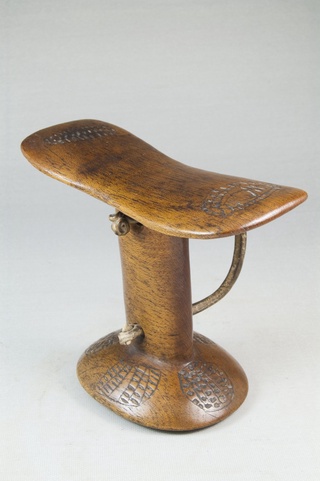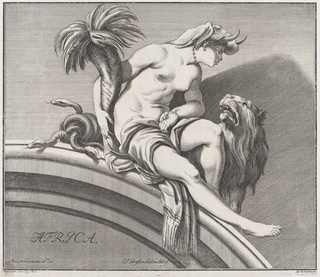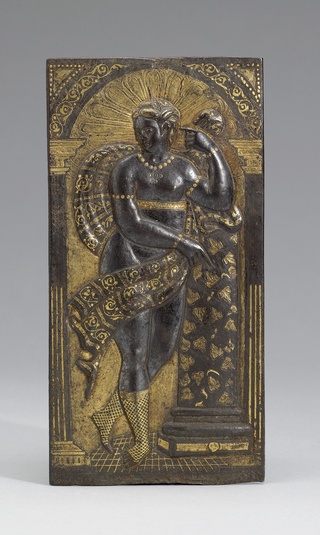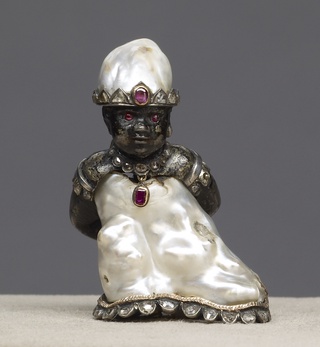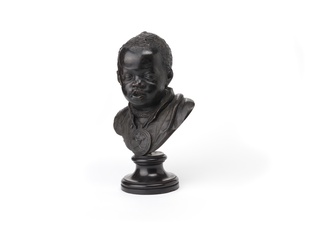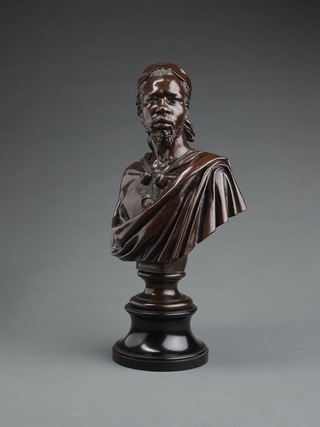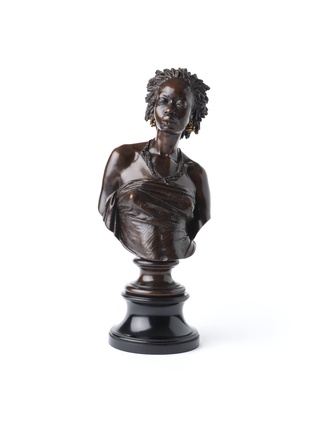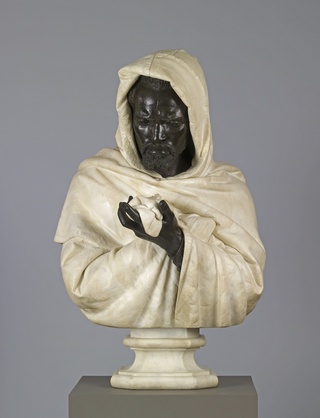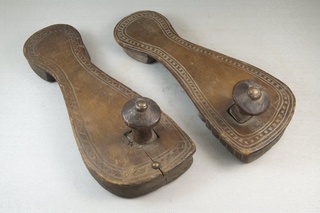In the Shape of an African
By Awuor Onyango•September 2023•46 Minute Read
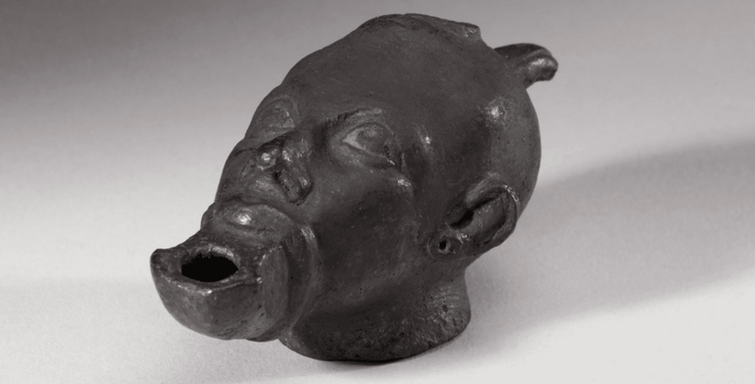
Unknown, Oil Lamp in the Shape of an African's Head, ca. 1540, bronze. Walters Museum, CC0.
The figure of the African is continually misrepresented in paintings and sculptures of the eras of slavery and colonialism. In particular, allegorical paintings and sculptures which depict Africa personified as a woman show how white Europeans misrepresent the continent as wild and uncivilised. These harmful distortions dangerously perpetuate anti-Black ideologies today. African responses to these distortions include the ideals of romantic gloriana, romantic primitivism, and negritude.
Searching through Curationist’s partner archives for representations of Africans is like looking at the galaxies with your bare eyes, trying to piece together what the sky looked like before the stars exploded. The fractured skies have left behind many ghosts, invisible and quiet, trapped in artefacts sorted into categories that only make the schism wider. As I analyse paintings, sculptures, and colonial maps that portray Africa as wild and uncivilised, I can't help but feel uneasy about navigating archives that were created for and by individuals outside of Africa's diverse cultures.
My hope is to discover an artefact that holds a ghost that has the power to erase the assumptions we unconsciously make about African collections. I seek an item that can shed light on the identity of its previous owner and the circumstances that exiled it from its original context and into our archives.
Cesare Ripa, Iconologia, traduit par Jean Baudoin, 1643. Internet Archive, public domain.
I simplify my approach and ask which artefact has the potential to challenge our misconceptions about gender in Africa and disrupt the colonial patriarchal narratives that have been presented as unquestionable truths. I am curious to know which of these artefacts were owned by women and which ghosts who haunt them may have had experiences similar to mine.
In the process of examining these artefacts, trying to set free the locked up ghosts, I contend with two schools of thought that emerged in response to these representations of Africa: romantic gloriana, which claims Africa’s cultures had technologies that were not only similar to but also the progenitors of European, Asian, and other world empires; and romantic primitivism, which claims that African simplicity was both its beauty and its technology.
And the Category Is… Colonialism: “Kenya,” “East Africa,” and Other Inventions
My search for an artefact is hindered by the rigid categories that shape these archives. As a member of an ethnic group that has only resided for five centuries in what is now called Kenya—an independent nation that has existed for just 64 years—it's difficult to find items that are directly tied to my identity. Even the history of Nairobi, the city where I was born, is relatively new, spanning only 164 years. The presence of colonisation and white ideology has left little untouched, and any artefacts that might exist are often missing from these archives.
Invisible Women and Colonial Cultural Policies
To find the invisible women hidden in the fractures using labels such as Kenya (64 years old) and East Africa (23 years old) to keyword searches in museum databases may prove futile. Even when combined with descriptive terms like woman, Luo, and various ethnic backgrounds, and including a specific time period, these categorisations don't seem to work.
East Africa already has a reputation for having no art. The British, who saw themselves as the cultural arbiters of the world, looked at dissimilar artistic canons and labeled it a lack. One of their colonisation policies was to introduce “the arts” to its East African colonies of Kenya and Uganda. It was believed that by educating the populace in Western art forms, they would be "civilised" and become more like their colonial masters. By controlling the art education system in Kenya, the British sought to shape the artistic tastes and preferences of the locals. This, in turn, helped to reinforce their power and control over the colony.1 2 3
One example is the prevailing notion of womanhood in Kenya. British colonialism enforced oppressive ideals on native women. During the colonial period, Kenyan women who were deemed "dissident-adjacent" were subjected to torture camps where they were taught to behave like so-called “proper” ladies through activities such as crotchet.4 Failure to comply meant facing sexual assault.5 As a result, British ideas of motherhood and associated values of feminine decency and modesty, female morality, women's hygiene, and their judgments placed on native dance, art, poetry, and crafts became the adopted national norms in Kenya, perpetuating the legacy of colonialism.6 Instead of evoking the spectre of neocolonialism or postcolonialism, these legacies are much more subversive in their reshaping of native psyches. I wore a kilt and learned “celtic dancing” as part of a traditional dance module in Kenya’s public school, 30 years post-independence—no post- or neocolonial theory can fully capture the ridiculousness of that experience.
Ghosts in the Archives/Artefacts
This tension of navigating archives not meant for my eyes—that didn’t anticipate my presence, that disappeared my fragile national identity in a 64-year span, that is tied so neatly to the appearance of the British and the subsequent independence from the coloniser—weighs me down. The ghosts I seek, the fractures I yearn to mend, are lost in categories to which they wouldn’t recognize themselves as belonging.
With a sigh, I expand my search using the broad term "African," desperate to discover the password that leads me home. What does African even mean? Hassan Minhaj and Ronny Chieng arguing over whether Indians are Asians crosses my mind—not that there’s any question over whether Kenyans are African.7 Archeology tells us East Africa was the birthplace of humankind, 2.8 million years ago.8 Are artefacts from this time labelled Tanzanian, Ethiopian, East African, Kenyan? I’m suspicious whether the search term African will disappoint me in the same way Kenya and East Africa have, by swallowing and drowning my specificity in lack. Kenya didn’t exist 64 years ago, therefore Kenyan people, culture and things didn’t exist 64 years ago. I have to think of who these categories were made by and for, whom these collections are meant to educate, what story they are supposed to tell, and for whose benefit. I ask which of these constellations of artefacts can challenge the colonial patriarchal narratives passed on as absolute truths. Is there an object here that can expand our misunderstanding of gender? Is there one which belonged to a woman? Which of the ghosts tethered to them were anything like me?
Inventing Africa: Allegories of Africa
Francois Dubois, Allegories of the four continents: Africa, 1834. Public domain.
With mixed feelings, I find myself staring at a series of paintings and sculptures depicting Africa as a woman. In one respect, seeing Black women fulfills some desire on my part to be represented; in another, the ghosts of the white hands that painted them as allegories speak louder than I was prepared for.9
These representations were eventually standardised in the book Iconologia (1593, illustrated in 1603) by the Italian Cesare Ripa, and supplemented by contemporary travel accounts. In Cesare's book, the figure of Africa is “almost naked; frizl'd Hair; an Elephant's Head for her Crest; a Necklace of Coral; and Pendants of the same, at her Ears; a Scorpion in her right Hand, and a Cornucopia, with Ears of Corn, in her left; a fierce Lion by her, on one Side, and a Viper and Serpent on the other.”10
This hodgepodge of references oversimplifies the facts on a ground coloured by prejudice. Although maize was introduced to the continent in the late 15th century by the Portuguese, Asia remains the continent with the highest number and species of snakes, and only half the countries in Africa ever had lions, the humanist desire to establish a fixed iconographic tradition gained strength and persisted into the 18th century.11 12
Jan Visscher, after Nicolaes Berchem, Allegory - An African maiden with the horn of plenty. Illustration from Johannes Blaeu, Atlas Maior. Amsterdam 1662. No known copyright.
This kind of coding is evident in Jan Visscher’s Allegory - An African maiden with the horn of plenty. This allegorical image of the African continent comes from Johannes Blaeu’s Atlas Maior published in 1662 in Amsterdam. An African woman is centered in the illustration, and Africa is portrayed as a land of unique beauty, with stunning architecture and diverse wildlife including snakes, scorpions, lions, and a majestic elephant, which have now become de rigueur archetypal African wildlife for the West. However, this depiction omits or downplays the impact of the slave trade and the suffering of enslaved people, instead focusing on the abundance of natural resources such as rich fabrics, ivory, and gold, which were major exports from the Guinea or Gold Coast region during that period.
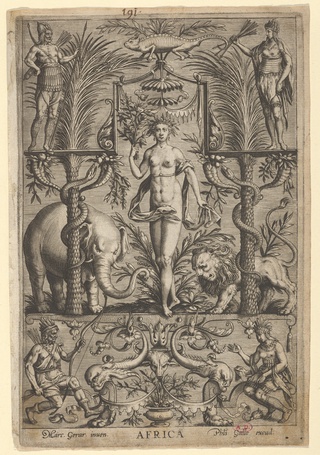
All of these exoticising tropes propping up the allegory of female and wild Africa can be seen in multiple works, including the Dutch engraving titled Allegory of Africa. The elephant is angry here, too. It’s important to note that all continents are rendered female in the Iconologia, evoking the corporeal as female and the incorporeal male, a rule most gendered European languages follow. This is important seeing as these allegories were about the continents as land mass and not as cultural identities, but also because of harmful tropes of the feminine and female as available to plunder, exploration, and domination.
Nicolai Abildgaard, Allegory of Africa. Royal Danish Collection, public domain.
On the Royal Danish Collection’s webpage for Nicolai Abildgaard’s Allegory Of Africa we’re told: “The black woman and the lion symbolize Africa. Like America, she is naked in order to underline the age’s conception of her wild and uncivilised nature.”13 These images reflected a dominant perspective rooted in white European Christian male-centric beliefs. The allegories served to reinforce the notion of Europe as superior and civilised compared to other continents during the era of triangular trade.14
Another depiction’s legitimacy is challenged because of its similarity to European depictions of a Greek goddess.15 Plaque with the Personification of Africa (?) is of stamped gilded iron, with a figure whose shoes and exotic drapery indicate her as a huntress of non-European descent. However, whether she’s African is disputed by the question mark the museum has allotted to it in the title. The nudity is standard but the shoes and the materiality of the piece seem to be too advanced for a depiction of Africa.16
What social and political commentary is hidden in stripping Africa nude, in feminising her? What needs to be tamed in this narrative? Africa is represented as the antithesis of Europe, uncivilised where Europe is civilised, immoral where Europe is the home of morals, female geography to masculine political power. This story prevents multiple realities from being seen, recorded, cherished and handed down. The stakes are high because another morality can be imposed on its people who are deemed too wild to self-define. These ideas of Africa as “wild and uncivilised” continue to trap the multifaceted psyche of an entire continent and its vast multicultures under their invisible weight.17
They also offer a strange gift in the form of a series of objects made for European consumption: blackamoor jewellery.
Blackamoor Jewellery and Askari Sculptures
Blackamoors are a trope in Italian decorative art, showcasing individuals with dark skin, often depicting Moors who were forced into servitude or slavery. These depictions are commonly found on furniture, as well as in paintings, jewellery, and textiles. The blackamoor motif originated as a creative expression of European interaction with the Moors in the 17th century. The word “Moors” describes a group of dark-skinned Muslims from the Middle East and North Africa who inhabited multiple regions of Europe during the Middle Ages. Nowadays, there remains a substantial industry producing blackamoors in Florence and Venice, with numerous factories offering customizable options.18
The Walters Art Museum collection features an enamelled brooch from Germany that depicts an African, perhaps a child, adorned in lavish attire, but shackled and kneeling in captivity. The accompanying caption indicates that the brooch aligns with the hierarchical societal views prevalent in Europe in the early 18th century that justified the subjugation of certain groups as an aspect of natural law.19 In this view, as Tamara Lewis writes, “There is a direct relationship between 'inner character and outer appearance,' to paraphrase [Kim F.] Hall, and since the outer has been clearly defined on the basis of skin colour polarities—whiteness and blackness—the internal soul is likewise marked. Thus, in Renaissance culture, skin colour was associated with morality. For example, those persons with darker skins were judged essentially uncivil and barbaric.”20 According to this worldview, Black people were meant to remain in chains on their knees, as they were viewed as wild and uncivilised, undeserving of liberty.21
Unknown artist, Earring with Head of an African, 1850. The Walters, CC0.
Unknown artist, Earring with Head of an African, mid-19th century. The Walters, CC0.
Unknown artist, Stickpin with Head of an African, mid-19th century. The Walters, CC0.
Other blackamoor pieces, such as earrings and stickpins sporting the head of an African, may appeal to individuals like Princess Michael of Kent, who indulge in glorifying images of slavery and harbouring racial domination fantasies.22 Although this specific jewellery item was made in France, and not in Italy, it promotes the tradition of blackamoor imagery.
The similarity between the Askari sculptures of colonial Kenya and blackamoors is striking. These sculptures, or wood carvings, as the British label them, are often found in lodges and curio shops. They depict intriguing characters—Black colonial officers wearing shorts as a symbol of subordination to the white rule. Askari officers were viewed as terrorists and traitors by the native Kenyans, but valued by the British as native informants who worked closely with European colonialists. However, what makes these sculptures truly fascinating is the colonialist imagination projected upon them: a fantasy of what Kenya and its people might have become had they only accepted their designated place within the natural order.
A complication arises from the fact that the sculptures are carved by individuals within the Akamba community. The Wakamba people were particularly known for their skilled commercial carving. The Askari sculptures are largely attributed to Mutisya Munge.23 Munge himself served as an Askari in the King's African Rifles during the First World War and used to create carvings to illustrate his life in his spare time.24 This became a profitable enterprise for the Kamba due to the enthusiastic market demand among white buyers. It is noteworthy that the appeal of these sculptures lies with the white clientele, as the figures’ iconography signifies “the good natives”—the so-called "noble savage" who submitted to and served their European conquerors unquestioningly.25 26
It’s interesting to note that while the men are marked as either resisting or aiding in colonial endeavours, the women are quite literally set aside. Those who resist are believed to do so out of insanity or the men’s bad influence, are bundled into trucks and ferried to torture camps where they are forced to learn crafts and how to have 4 o’clock tea ready for their children and their husbands when they come home from work or school respectively. The men, one particular man who survived World War I, can become sculptures but the women can only become ladies.
One can only imagine the impact of blackamoors and similar artefacts on white collectors’ psychology and the concomitant treatment of and attitude to Africans. What started as Mutisya Munge’s sculptural documentary of his life experience was decontextualized and catapulted into a venture that commodifies and tokenizes the African World War soldiers it seeks to idealise. For the West to collect these sculptures is to establish that the Askari are primitive. No matter what clothes they wear and no matter whose economic system they participate in or, indeed, are subjugated by, this Others them. To better understand this dynamic, it's necessary to delve into the concept of romantic primitivism.
Romantic Primitivism/Tigritude
During the romantic era, in the late 18th and early 19th centuries, a concept called romantic primitivism emerged in Europe and was adopted for political purposes by Africans. This notion idealised the lifestyles of primitive societies as being more authentic, pure, and guiltless compared to the modern and industrialised societies of that time.27 A select few societies within Africa were elevated from the kind of savagery linked to moral decay, to the status of noble savage, romanticised for their connection with nature and embodying certain characteristics favourable to European domination of the continent. Under romantic primitivism, the nobleness is part of the romance, is what distinguishes the morally decayed savage in need of a lesson and salvation (the blackamoor) from the morally upright savage that will save the European from the cruelty of having to deal that lesson themself (the askari). The nobleness is part of the romance. To be a noble savage, you must set yourself apart from your own; the blackamoor and the askari are two sides of the same coin, the (shackled) savage and the (shackling) noble savage.
Another example of the West’s use of the “noble savage” trope would be how the Maa people (Maasai) are represented in the West, sculptures of their “legendary” warriors now even more common than Askari sculptures. This framing as the "noble savage" perpetuates stereotypes of non-Western cultures as being static and unchanging, while simultaneously appropriating their cultures by taking their artefacts, ideas, and images out of context and interpreting them for Western audiences.28 For instance, blackamoor jewelry…
Romantic primitivism does not counter European cultural arrogance by asserting civilisations comparable to that of ancient Greece.29 On the contrary, this school takes pride in precisely those traditions which European arrogance would seem to despise. It takes a “yes, but…” approach to European ideas of cultural dominance, disregarding other cultural perspectives. If Africa is depicted as the antithesis to Europe, romantic primitivism agrees, then swiftly defends its right to be “other.” Romantic primitivism responds to all the white ideologies around technology and civilization with a silence that’s often confused for agreement, thereby reinforcing the explanation of the dominant culture.30 For instance, when the British label Kenyan sculptures as wood carvings, the Kenyan artist may shrug since it is meaningless to them. However, this shrug is sometimes mistaken for approval. In context, the Askari sculptures were Mutisya’s personal record, and yes, he is an African thrust into the world stage to fight a British war, named a part of the King’s African Rifles, survives and returns home to make sculptures of soldiers. This is not the same as interpreting his artwork as constituting his assent or consent to colonial power dynamics. In the same way books can turn into movies about white women meeting a maasai man and giving up "the west" to become "The White Maasai" are emblematic of the feverish exoticization that belies romantic primitivism
In the midst of these misperceptions, the concept of romantic primitivism gains strength in Africa, reminding us of Wole Soyinka's quote, "A tiger need not shout its tigritude." This suggests that authenticity can be sensed without explicit proclamation. However, this relies on who is charged with recognizing this authenticity, the assumption relies on us being tigers ourself, on our familiarity with and ability to recognize a tiger. If blackness is antithetical to whiteness, Africa antithetical to Europe, can a tiger trust it is being perceived as one by the white man who has already othered the tiger as a “noble savage”? A Swahili expression, loosely translated as "Don't confuse a rain-soaked lion for a house-cat," highlights the significant distinction between the two, allowing for an alternative perspective.31 For a human whose only encounter with the panthera family is a domestic cat, they may mistake a wet lion for a house-cat, just as individuals may interpret a cultural artefact without being aware of its cultural context. At the same time, differentiating between a wet lion and a domestic cat doesn’t make you an expert on being a lion. To flatten tigritude down to the sound a tiger makes is to look through a colourful kaleidoscope and see only white.
The archives do a lot of flattening, simplifying complex contexts. I have seen this happen before when my fragile identity disappears into the 64 year span of the existence of Kenya. The archive and the erotic are opposing forces, as Esther Perel says. “Eroticism is . . . the spirit that creates new life [even] when death is ever-present [in the archive].” Because in these archives this Spirit dies under categories, perspectives, and ideologies foreign to me. To people not from the West, to people like me, the archive is the everpresent death.32
In the Shape of an African
This brings us to an oil lamp “in the shape of an African,” from an unknown Italian artist—definitely a blackmoor ornament.
Unknown, Oil Lamp in the Shape of an African's Head, ca. 1540, bronze. Walters Museum, CC0.
Unknown, Oil Lamp in the Shape of an African's Head, ca. 1540, bronze. Walters Museum, CC0.
A similar lamp has been referred to as a “heathen head.” It’s important to contextualise the word heathen or kaffir, which is considered a racial slur in South Africa. Lewis points out, for example, that “George Abbot’s Briefe Description of the Whole Worlde (1599) emphasises the heathenish state of sub-Saharan Black Africans being neither Muslims nor Christians. His views influenced the cultural and ideological climate of his times, which directly led to the 1601 Elizabethan Edict expelling Blacks from England on the basis of their incapability of acquiring true religion.”33
If the Askari sculpture of Kenya is an ode to the noble savage, the garlic at the door preventing the vampiric native entry, this oil lamp is a perfect warning to the ignoble heathen of what might happen to them should they venture too close. It moves from the amputation “bust” style of the previous ornaments, coming closer to a simple decapitation. This iconography is reminiscent of torture, slavery, and with the wick as his tongue, it even evokes the burning of Black bodies. It goes beyond dignity in a way that can’t be articulated but felt in my bones. With complete disregard to my identity as a viewer, this lamp expands on misplaced ideas of the wild, the uncivilised, the untamed Other.
Lifting the Curse of Blackness: Slavery and Abolition
The dehumanisation of Africans played a central role in justifying the inhumane treatment of Black people during slavery. The portrayal of Africans as savage and immoral in Eurocentric iconography served to recast Black people as deserving of torment and subjugation. Many binaries were formed and upheld in literature as well as in iconography, the christian and the heathen, the savage and the civilised, the cursed and the divinely ordained. George Best writes that black colour “proceedeth of some naturall infection”, a curse, explained in Genesis 9–10. According to Best, Cham disobeyed Noah’s orders that there should be no sexual intercourse on the ark, and as punishment Cham’s son Chus “should be so blacke & lothsome, that it might remaine a spectacle of disobedience to all the World.” In 1584, Reginald Scot’s Discoverie of Witchcraft also demonised Black skin as a curse.34
However, sculptural works by Charles-Henri-Joseph Cordier of France and Jan Claudius de Cock of Belgium try to counter this harmful narrative by bringing dignity to Black figures. These works represent a significant shift in perspective, aiming to elevate and humanise the Black figure rather than dehumanising and stigmatising the Black person.
Jan Claudius de Cock's sculpture, Bust of an African Boy in Servant's Livery, is widely considered one of the most sensitive early representations of a Black boy by a European sculptor. This sensitivity is rooted in the human-like qualities of the bust, with its facial features neither exaggerated nor imagined, and the expression recognizable and free of any strong preconceptions.
Although the boy in the sculpture was likely a slave, given the time period in which de Cock created it, the bust does not depict him with any explicit indicators of his social status. His body is not shown in manacles or twisted in some kind of laborious activity. Instead, he is captured simply as he is, in the garb of a servant.
After seeing the oil lamp “in the shape of an African,” this piece feels less traumatising to study. Perhaps de Cock chose a little boy as a subject to highlight the deep evils of slavery. Despite this sensitivity, however, the boy's identity remains lost to us, another fissure too wide to jump over, too deep to peer into. Without a name or other personal identifiers, we are left unable to make any meaningful connection to him as a unique individual with a specific history. Nonetheless, the sculpture stands as a testament to the importance of representing Black figures in a way that highlights their common humanity, rather than negative stereotypes or oppressive social structures. By portraying the boy as a faceless representation of a particular class or status, de Cock offers an alternative, differently dehumanising representation of Blackness.
Charles-Henri-Joseph Cordier created two sculptural busts, one of a man and one of a woman, that were intended to “humanise” Black figures in the eyes of a white audience. The African Venus sculpture currently bears a title with a Eurocentric reference to the ancient Roman goddess of love. The original title of the piece, Black Woman from the Colonies, was renamed in 1857 by French critic Théophile Gautier. However, his work is not without fault. Cordier claims that the sculpture was modelled after the appearances of several women but does not provide their names or identities. This erases the specificities of the Black woman’s composite identity, as her story is subsumed into the agenda of ennobling her.
Cordier’s companion piece, now titled Saïd Abdullah of the Mayac, Kingdom of Darfur (Seïd Enkess), was exhibited in its bronze version as Nègre de Tombouctou (Black man from Timbuktu) at the Salon of 1851 and gained widespread popularity. Cordier submitted the original bronze bust—along with that of the companion female portrait—to London’s Great Exhibition in 1851.35 Queen Victoria purchased the pair in 1852. However, Enkess was a former slave born around 1821 in the region of Mayak—possibly Mayak’elo in Dire Dawa, Ethiopia—in northeastern Africa, far from Tombouctou. As a child, he was captured in a slave raid, sold in Cairo, and eventually brought to France. By 1840, he had become an established artist’s model.36
Cordier first exhibited a plaster bust of Enkess as Saïd Abdallah, de la Tribu de Mayac, Royume de Darfour (Saïd Abdallah from the Mayak Tribe, Kingdom of Darfur) at the Salon of 1848, the same year that France abolished slavery throughout the nation and its colonies. Cordier later reflected that the portrait itself was “a revolt against slavery . . . widening the circle of beauty by showing that it existed everywhere.”37 This work made Cordier’s reputation, leading him to cast the bust in bronze two years later as Nègre de Tomboucktou, capitalising on its popularity. This deliberate change in title, replacing a personal name with a geographical designation, transformed Enkess from a unique individual into a generic “specimen” of racial and cultural difference.
The Italian Pietro Calvi’s sculpture of the Shakespearean character of the “Moor” Othello, known in at least ten marble versions, seems slightly different. Calvi’s Othello intersects with and challenges the assumptions of 19th-century ethnographic sculpture, which sought to depict racial "types" and thus denied subjects their individuality. Typically, non-white figures were depicted as savage or lazy. Calvi, on the other hand, presents Othello as a deep-thinking, emotionally complex character. The sculpture is believed to be modelled on Ira Aldridge (1807–67), a Black actor, a year after his death. Aldridge was famous for his portrayal of Othello and used his platform to speak out against slavery.
The importance of these sculptures lies in their ability to challenge the dominant Eurocentric narrative that has long been used to justify violence against Black people. By bringing dignity back to Black figures in these works, Cordier, de Cock, and Calvi begin the process of restoring cultural and social narratives that disrupt oppressive structures that have long been ingrained in western societies.
While these images are meant to challenge some of the harmful stereotypes that have been passed down through art history, from iconologia to blackmoor jewellery, they are still positioned within the European canon, using European visual language to speak to a western-educated audience about a European ideal of representation. This highlights the need for responses to the question of Black bodies, Black cultures, and Black artefacts that do not rely on European canons: romantic gloriana.
Romantic Gloriana
To distinguish between the Elizabethan gloriana, its proliferation of Shakespeare as the best thing to ever happen to the written word and his era being the golden age for the arts worldwide, and romantic gloriana, we borrow from this concept its main ideas. Namely, gloriana as a descriptor of an era of outstanding cultural and artistic achievements, military conquests, exploration, and scientific discoveries; an era worthy of national pride. For a nation, a people, a continent to have a golden age, these requirements are often in need of highlighting. Romantic primitivism holds that, although these elements were missing, this simplicity is its own virtue. Romantic gloriana, on the other hand, insists that they were in fact present. As Ali Mazrui explains:
Defending themselves against European contempt, one school of African thought emphasised that Africa before the European had had its own complex civilisations of the kind that Europeans regarded as valid and important, civilisations which produced great kings, impressive empires and elaborate technological skills. This particular school of African thought looked especially to ancient Egypt as an African civilisation, and proceeded to emphasise Egypt’s contribution to the cultures and innovations of ancient Greece.
We may call this school of African assertion a school of romantic gloriana. It seeks to emphasise the glorious moments in Africa’s history defined in part by European measurements of skill and performance, including the measurements of material monuments.39
The romantic gloriana view emphasises the monumental side of African history, focusing on the grandeur and achievements of ancient African civilizations. It highlights the ingenuity and skill of African societies and refutes the stigmas that have often been perpetuated about African cultures such as backwardness, primitiveness, or savagery.40
Some African states have historically transformed into cultures of monuments, developing into brick-and-mortar civilizations. Monuments such as the pyramids of the Nile, castles and churches in Ethiopia, the awe-inspiring ruins of Great Zimbabwe, and the remains of Gedi in Kenya visually remind us of this remarkable aspect of African history. By emphasising the monumental aspects of African history, romantic gloriana stands in contrast to the negative viewpoints that emerged during the colonial era, which were intent on minimising or erasing African historical achievements or portraying African societies as unenlightened and inferior to European ones.However, it is essential to note that Romantic gloriana does not negate or ignore the atrocities and injustices that took place during Africa's history, such as slave trading and colonial exploitation. It instead offers a more nuanced and comprehensive understanding of African history that encompasses its monumental achievements and cultural richness, as well as its struggles and challenges.
The preeminent example of such a culture in Kenya is the Swahili, the producers of these carved wooden “Pair of clogs” or Viatu vya mbao, their actual name. The Swahili have a diverse heritage that includes Bantu, Arab, Persian, Indian, Chinese and European (mainly Portuguese) influences. The origins of the Swahili are uncertain, but it is widely believed that they emerged as a distinct cultural group between the 6th and 10th centuries, following the establishment of trade relations between the Arabian Peninsula and the East African coast. At this time, Swahili city-states began to emerge along the East African coast, drawing their wealth and power from trade in gold, ivory, and slaves; recorded on the Kenyan coast as “precious cargo.” The incorrect naming of these viatu vya mbao is telling: Swahili Clogs. Clog, a Dutch wooden shoe from the 13th century, becomes the operative term for wooden footwear, all wooden shoes, whether they’re from Japan (geta) or Kenya (viatu vya mbao) or the Netherlands.
Where romantic primitivism doesn’t shout about tigritude, romantic gloriana screams: we are civilised, even by your standards, we might have been the ones to civilise you, we invented, we conquered, we had military might and complexity that you might never understand and that you underestimate. It stands on the other side of Wole Soyinka’s quote. In fact, it births the very movement Wole Soyinka was attacking with that quote on tigritude: negritude.
Negritude
The negritude movement, which emerged in the 1930s among Francophone African and Afro-Caribbean intellectuals, aimed to challenge colonialist stereotypes with a positive image of Black culture and heritage. Considered a predecessor of the Black arts movement and the Black consciousness movements, negritude does more than assert the ideals of African histories through the filter of romantic gloriana. Yes, African institutions are mentioned, but so are the works and lives of people of African descent. The movement emphasised the uniqueness and value of the Black experience against the dehumanising stereotypes perpetuated by colonial powers.
Unknown, Wilfredo Lam in his studio, 1964. Wikimedia Commons, public domain.
Negritude was characterised by a celebration of Black cultural heritage, as well as a rejection of assimilation into the dominant, white Western culture. The past, amorphous and unchartable, is summoned and coaxed, woven into the present and projected into the future, as values rather than artefacts and monuments erected as proof of these values.
Negritude brings the hunter-gatherer from whom the immoral savage and the noble savage emerge, and the woman-king together in dialogue to establish a collective cultural identity among people of African descent. Because Africa, like Kenya and East Africa, was never truly an identity marker as much as it was a geographical one.
Reshaping Africa through Negritude
One of the ways in which negritude can impact African artefacts in museums is by providing an alternative contextually-rich different perspective on these objects.
Traditionally, African artefacts have been interpreted and displayed in Western museums from a colonial (the label Kenya) or ethnographic (the label Swahili Clogs) perspective, lenses which automatically relegate them to being viewed as primitive or exotic curiosities. The negritude movement offers an alternative lens, one informed by an appreciation of African culture and heritage and an understanding of the cultural and historical contexts in which these artefacts were created. Poetry, oral, unwritten, ephemeral is held at the same level as a monument, large, static, indestructible. The terms and centre shifts finally, softly, from European ideals and perspectives back into the hands of Africans.
Both romantic primitivism and romantic gloriana use European markers; morality and monumentality. By emphasising the cultural and historical significance of African artefacts, the negritude movement can help to facilitate a more nuanced and respectful approach to their interpretation and display in museums. This might involve rethinking the traditional categories and classifications used to group African objects, such as dividing them by tribe or geographic region. Negritude recognizes the damage done to the Black psyche by these European-produced images and categories while rejecting the images as absolute truth. Negritude maps the exact dimensions these iconographies have trapped us in while praising the erotic that survived its pains; slavery, colonialism, dehumanisation, encouraging a more holistic approach to interpreting these artefacts, one that takes into account their cultural, religious, and symbolic meanings.41 As Audre Lourde points out, “The erotic is the nurturer or nursemaid of all our deepest knowledge.”42
The negritude movement challenges the so-called objective museum/archival perspective shaped by the often-invisible white hands that collected African artefacts. This movement also considers how the definition of femininity fundamentally differs in the European and African psyche, particularly in terms of colonialism, slavery, and language. The renaming and recontextualization of African artefacts consequently erase the stories of those who used them, and those whose cultures produced them. For instance, when a kiatu cha mbao becomes a clog, much of its contextual and cultural significance is lost in translation. The centre or reference point of these objects may also be mistakenly placed in Europe rather than their original African context, resulting in the kiatu cha mbao’s displacement from the streets and floors they once walked.
Conclusion
To correct Cesare Ripa’s Iconologia of the continent, and the teeming allegories that derive from it, seems almost impossible today: in many African societies, wealth and bounty were linked to cattle and children, not corn; her hair would not look like that; Africa’s landscape is too diverse to settle on a backdrop; there might be either a plant-based or hide-based cloth in place of the nudity—but even this critique is coming from a second generation Kenyan whose parents were both born before Kenya gained independence. The ghost is still nameless, but not as fragile, reconstituted into the community, the context, the labels and languages of her own understanding. The ghost is reformed and remembered, the fractures acknowledged and named.
Awuor Onyango is a 2023 Curationist Critic of Color. She is a writer and multisensorial artist based in the pagan citadel of Nairobi, Kenya. Their multidisciplinary and multisensorial approach is rooted in the ephemeral, interactive and lived art traditions of East Africa, inviting, engaging, honouring and centering the voice of the side-lined, erased, in danger of amputation, aiming to integrate our ruptured histories, mythologies and philosophies into present technologies.
Citations
See British civilising efforts worldwide. With the decision in 1954 to detain suspected members of the anti-colonial Mau Mau guerrillas en masse, the colonial administration in Kenya also settled on a policy for the “rehabilitation” of detainees. This program, first modelled on the strategies used by the British in Malaysia to remake Communist rebels into obedient subjects, was meant to assuage criticisms of the detention camp system by showing evidence of a “civilising” effort. See Elkins, Caroline. Britain’s Gulag. Vintage, 2005. See also “The Struggle for Mau Mau Rehabilitation in Late Colonial Kenya.” The International Journal of African Historical Studies, vol. 33, no. 1, 2000, pp. 25, https://doi.org/10.2307/220257 and Said, Edward W. Culture and Imperialism, 1994. Said writes: “The power to narrate, or to block other narratives from forming and emerging, is very important to culture and imperialism, and constitutes one of the main connections between them.” See also Mugo, Micere Githae. Culture and Imperialism, 1987; and, finally, Bruce-Lockhart, Katherine. “‘Unsound’ Minds and Broken Bodies: The Detention of ‘Hardcore’ Mau Mau Women at Kamiti and Gitamayu Detention Camps in Kenya, 1954–1960.” Journal of Eastern African Studies, vol. 8, no. 4, August 2014, pp. 590–608, https://doi.org/10.1080/17531055.2014.948148. Accessed 22 June 2023.
See “Introducing East Africa (No. 2).” Colonial Film, www.colonialfilm.org.uk/node/2527. Accessed 23 June 2023. The synopsis reads: “Makerere College - East Africa needs a more highly educated class which can assume white responsibilities without becoming alienated from the common people. Simple Africans must be taught a ‘healthy life’. Practical education in simple improvements is the most effective—these people will have to depend on human and animal power for some time to come.”
See Wolukau-Wanambwa, Emma. “Margaret Trowell’s School of Art. A Case Study in Colonial Subject Formation.” In Susanne Stemmler, ed. Wahrnehmung, Erfahrung, Experiment, Wissen. Diaphanes, 2014, pp. 101–122, www.another-roadmap.net/articles/0003/3069/eww-margaret-trowell-s-school-of-art.pdf. Accessed 22 June 2023. Margaret Trowell founded an art school for Africans in Uganda in the 1930s. This essay explores how Trowell's arguments for introducing fine art and her teaching methods reflect a vision of extending colonial control through art education, despite her intentions for emancipation.
High ranking officials within the colonial administration were engaged in intense debates around the sanity of the women detainees, leading some officials to advocate for classifying them as insane. Understanding the British approach towards these detainees highlights the influence of gender, deviancy, and mental health concepts on colonial punishment methods. In Hynd’s study, perceptions of madness are shown to have led to a more lenient treatment of female offenders on trial for capital punishment, despite rationalising their actions and having little medical evidence of insanity. See Hynd, Stacey. “Deadlier than the Male?: Women and the Death Penalty in Colonial Kenya and Nyasaland, c. 1920–57.” Stichproben. Wiener Zeitschrift für kritische Afrikastudien 12, 2007, pp. 13–33. See also Mckittrick, Meredith. “Faithful Daughter, Murdering Mother: Transgression And Social Control In Colonial Namibia.” The Journal of African History, vol. 40, no. 2, Cambridge UP, July 1999, pp. 265–83, https://doi.org/10.1017/s002185379900746x. Accessed 22 June 2023.
“How the British treated 'hardcore' Mau Mau women.” University of Cambridge, 28 August 2014, www.cam.ac.uk/research/news/how-the-british-treated-hardcore-mau-mau-women. Accessed 22 June 2023.
In certain regions of Kenya, as well as in Ugandan schools and other areas, there are still prevailing notions about modesty that encompass practices such as hair coverage, appropriate types and lengths of skirts, and even hair length. It is important to acknowledge that these beliefs continue to influence the choices and expectations placed upon women in these communities or educational institutions. See Noel, Sanya. “Exploring and Questioning Beauty: A Photo Essay.” This Is Africa, 27 January 2017, www.thisisafrica.me/lifestyle/exploring-questioning-beauty-photo-essay. See also M. “The Politics of the Miniskirt (and Hippies) in Africa.” Owaahh, 16 April 2015, www.owaahh.com/the-politics-of-the-miniskirt-and-hippies-in-africa. Accessed 22 June 2023.
“Hasan Minhaj and Ronny Chieng Roast the S**T out of Each Other.” The Daily Show. www.youtube.com/watch?v=szWiVSCwdSk&ab_channel=TheDailyShow. Accessed 22 June 2023.
“Homo Habilis.” The Smithsonian Institution’s Human Origins Program. 14 February 2010, https://humanorigins.si.edu/evidence/human-fossils/species/homo-habilis. Accessed 22 June 2023.
“After Marcus Gheeraerts the Elder | Allegory of Africa, from ‘the Four Continents.’” The Metropolitan Museum of Art, www.metmuseum.org/art/collection/search/385668. Accessed 13 June 2023.
Ripa, Cesare. Iconologia: Or Moral Emblems. London, 1709, pp. 53. Cited in Allison Blakely, Blacks in the Dutch World: The Evolution of Racial Imagery in a Modern Society. 1993, pp. 82. During the late Renaissance and Baroque periods, European views of Africa strongly influenced allegorical representations of the continent. These representations were shaped by limited knowledge, stereotypes, and perceptions of Africa as a mysterious and exotic land varied from notions of riches and abundance, to exotic wildlife and the "Otherness" of African cultures. Colonial interests, classical mythology, biblical narratives, and existing visual traditions further influenced these depictions.
For maize, see: Ortiz, Rodomiro and D.R. Vuylsteke. “Recent advances in Musa genetics, breeding and biotechnology.” Plant Breeding Abstracts. 66 (10), 1996, pp. 1355-1363. See also Badu-Apraku, Baffour, and M. A. Fakorede. “Morphology and physiology of maize.” Advances in Genetic Enhancement of Early and Extra-Early Maize for Sub-Saharan Africa, 2017, pp. 33–53, https://doi.org/10.1007/978-3-319-64852-1_3. For decreasing lion population, see “Vanishing Lions – a 75% Decline in Africa’s Iconic Predators in Just Five Decades.” Africa Geographic, 1 November 2022, www.africageographic.com/stories/vanishing-lions-a-75-decline-in-africas-iconic-predators-in-just-five-decades/. Accessed 23 June 2023. For iconographic language, see “Artwork of the Month – Allégorie de l’Afrique - Fondation Gandur Pour l’Art, Genève.” La Fondation Gandur pour l’Art, www.fg-art.org/en/artwork-of-the-month-archives/allegorie-de-lafrique. Accessed 23 June 2023.
“In each [European] language the word for ‘black’ carried a host for disparaging connotations. In Spanish, for example, ‘negro’ also meant gloomy, dismal, unfit, and wretched; in French, ‘noir’ also connoted foul, dirty, base, and wicked; in Dutch, certain compounds of ‘zwart’ conveyed notions of anger, irascibility, and necromancy; and ‘black’ had comparable pejorative implications in Elizabethan and Stuart England.” Vaughan, Alden T. Roots of American Racism: Essays on the Colonial Experience. Oxford UP, 1995, pp. 6. See also Africanus, Leo et al. The History and Description of Africa. The Hakluyt Society, 1896, https://archive.org/details/historyanddescr03porygoog/page/n4/mode/2up and Abbot, George. A Briefe Description of the Whole Worlde. 1599.
“Allegory of Africa | the Royal Danish Collection.” Amalienborg, www.kongernessamling.dk/en/amalienborg/object/allegory-of-africa. Accessed 23 June 2023. See also Vaughan, Alden T., and Virginia Mason Vaughan. “Before Othello: Elizabethan Representations of Sub-Saharan Africans.” The William and Mary Quarterly, vol. 54, no. 1, January 1997, pp. 19, https://doi.org/10.2307/2953311. Accessed 10 June 2023: “Representations of sub-Saharan Africans . . . generally focused on difference, implying their natural inferiority and non-assimilability into English notions of civility and proper appearance [and] set them apart in English eyes and imaginations as a special category of humankind.” See also “Artwork of the Month – Allégorie de l’Afrique.” Fondation Gandur Pour l’Art, www.fg-art.org/en/artwork-of-the-month-archives/allegorie-de-lafrique. Accessed 23 June 2023. Asia and Europe are shown clothed, each iconography designed to show virtues, vices, and the prevalent cultural perceptions and biases of the time.
“After Marcus Gheeraerts the Elder | Allegory of Africa, from ‘the Four Continents.’” The Metropolitan Museum of Art, www.metmuseum.org/art/collection/search/385668. Accessed 23 June 2023. Africa was often depicted as a wild and untamed continent, inhabited by strange creatures and ruled by tyrannical and savage kings. These notions were perpetuated by travel accounts, exploration narratives, and colonialist perspectives of the time. It is important to approach these representations critically, as they often perpetuated stereotypes and biases prevalent at the time.
“Plaque with the Personification of Africa (?) | the Walters Art Museum.” The Walters Art Museum, https://art.thewalters.org/detail/24252/plaque-with-the-personification-of-africa-/. Accessed 22 June 2023.
As per the description under the image on the Walters Art Museum collection website, “This depiction of a beautiful woman as a hunter (indicated by her footwear) from outside of Europe (signalled by her exotically decorated drapery) is puzzling. Iron was rarely used for art, because it was hard to work, especially to create fine detail. To introduce the detail, sculptors turned to gold. Similar plaques decorated a splendid casket commissioned by Emperor Maximilian II. This use of iron may take advantage of the metal's colour to depict a black African, possibly as a personification of the continent Africa, one of the four continents (along with Europe, Asia, and America) then known to Europeans.”
Any of Fanon’s writings on amputation (and resistance to amputation) are helpful in understanding what this weight might look like. See Fanon, Frantz. Black Skin, White Masks. Penguin, 1952.
Rautenbach, Anneke. “Gaudy, Sure—but Racist Too? Unpacking Centuries of ‘Blackamoor’ Art.” New York University. 31 July 2015, www.nyu.edu/about/news-publications/news/2015/july/awam-amkpa-on-blackamoors-at-la-pietra.html. Accessed 22 June 2023.
“There is a direct relationship between “inner character and outer appearance” and since the outer has been clearly defined on the basis of skin colour polarities—whiteness and blackness—the internal soul is marked as well. Thus, in Renaissance culture, skin colour was associated with morality. For example, those persons with darker skins were judged essentially uncivil and barbaric.” Lewis, Tamara. "To Wash a Blackamoor White: The Rise of Black Ethnic Religious Rhetoric in Early Modern England." Dissertation, Vanderbilt University, 2014, https://core.ac.uk/download/pdf/216051184.pdf. Accessed 14 January 2024. See also Arendt, Hannah. The Origins of Totalitarianism. Harcourt Brace Jovanovich, 1968. Arendt extensively explores the historical and philosophical foundations of totalitarianism, including the roots of racism, imperialism, and social hierarchies. The book delves into the intellectual and cultural climate of Europe during the 18th century and how certain ideologies, such as social Darwinism and racial determinism, contributed to the justification of subjugation and discrimination.
Lewis, Tamara. "To Wash a Blackamoor White: The Rise of Black Ethnic Religious Rhetoric in Early Modern England." Dissertation, Vanderbilt University, 2014, https://core.ac.uk/download/pdf/216051184.pdf. Accessed 14 January 2024.
See Mayer, Ruth. Artificial Africas. UPNE, 2002. "Africa is an artificial entity,” notes Ruth Mayer, “invented and conceived by colonialism.”
Gonzales, Erica. “Princess Michael of Kent Wore a Racist Brooch to Lunch with Meghan Markle.” Harper’s Bazaar, 21 December 2017, www.harpersbazaar.com/celebrity/latest/a14481097/princess-michael-of-kent-racist-brooch/. Accessed 22 June 2023.
See Dick-Read, Robert. Sanamu: Adventures in Search of African Art. 1964.
Classens, Bruno. “The Legacy of Mutisya Munge: A Kamba Carver like No Other.” Bruno Claessens, brunoclaessens.com/2020/09/the-legacy-of-mutisya-munge-a-kamba-carver-like-no-other/. Accessed 21 June 2023.
“Noble Savage.” Wikipedia. 26 October 2019, en.wikipedia.org/wiki/Noble_savage. Accessed 21 June 2023. “A noble savage is a literary stock character who embodies the concept of the indigene, outsider, wild human, an ‘other’ who has not been ‘corrupted’ by civilization, and therefore symbolises humanity's innate goodness.”
Jean-Jacques Rousseau's concept of the "noble savage" had a significant influence on romantic primitivism. Rousseau believed that civilization corrupted human nature and that a return to a primitive, natural state would be beneficial for individuals and society.
Explorations and archaeological discoveries during the Romantic era, such as those in Egypt, Southeast Asia, and the Americas, introduced new and exotic cultures to Europe. The encounter with these "primitive" cultures sparked curiosity and a fascination with their perceived simplicity, authenticity, and connection to nature.
See Hayes, Kevin J. and Stephen Greenblatt. “Marvelous Possessions: The Wonder of the New World.” American Literature, vol. 64, no. 2, June 1992, pp. 367, https://doi.org/10.2307/2927841. Accessed 29 February 2020. See also Greenblatt, Stephen. Marvelous Possessions: The Wonder of the New World. University of Chicago Press, 1991; Ferguson, Moira and Mary Louise Pratt. “Imperial Eyes: Travel Writing and Transculturation.” Eighteenth-Century Studies, vol. 26, no. 3, 1993, pp. 481, https://doi.org/10.2307/2739415; Pratt, M. L. Imperial Eyes: Travel Writing and Transculturation. Routledge, 1991; Said, Edward W. Orientalism. Williams, Raymond. Keywords: A Vocabulary of Culture and Society. Oxford UP, 1976.
Mazrui, Ali. The Africans: A Triple Heritage. Little, Brown and Company, 1986.
For romanticism and Romantic primitivism origins, see “Alternative Sects: Romanticism, Primitivism, Adamites, Diggers, & Rosseau.” Deep Green Resistance, https://deepgreenresistance.net/en/resistance/culture/romanticism-primitivism-alternative-sects/. Accessed 22 July 2023: “Another current of Romanticism that eventually influenced our current situation was bolstered by philosopher Jean Jacques Rousseau, who described a ‘state of nature’ in which humans lived before society developed, arguing that there was a fundamental rupture between human nature and human society. He was not the creator of the image of the noble savage—that dubious honour falls to John Dryden, in his 1672 play The Conquest of Granada.” See also Goldwater, Robert J. “Primitivism in Modern Painting.” Parnassus, vol. 10, no. 7, December 1938, pp. 34, https://doi.org/10.2307/771609. Accessed 23 June 2023.
Usione simba amenyeshewa ukadhani ni paka.
Perel, Esther. “Letters from Esther #25: Eroticism in Hard Times.” Esther Perel, www.estherperel.com/blog/letters-from-esther-25-eroticism-in-hard-times. Accessed 22 June 2023.
Lewis, Tamara. ”’Wherefore She Made Suit‘: African Women’s Religious and Spiritual Determinism in Sixteenth and Seventeenth Century England.” Religions, 16 November 2017, https://www.mdpi.com/2077-1444/8/11/251. Accessed 14 January 2024. Winthrop D. Jordan’s 1968 book White over Black: American Attitudes Toward the Negro holds that Blackness as a concept is already firmly embedded in mediaeval English epistemology and associated with dirt, evil, sin, and the devil. According to Jordan, the English perceived the Africans as fundamentally different due to a combination of their perceived "lack of religion" and their skin colour. This unique perception of Africans contributed to the development of prejudices, which eventually evolved into English ideologies emphasising racial distinctions.
Best, George and Martin Frobisher. A True Discourse of the Late Voyages of Discovery. 1578; Bishop, George, Ralph Newberie, and Robert Baker. The Principal Navigations, Voyages, Traffiques and Discoveries of the English Nation. 1599. See also Chen, Kuan-Hsing, et al. “New Ethnicities.” Stuart Hall: Critical Dialogues in Cultural Studies. Routledge, 1996.
Lugo-Ortiz, Agnes I. et al. “Exquisite Empty Shells: Sculpted Slave Portraits and the French Ethnographic Turn.” Slave Portraiture in the Atlantic World, Cambridge U P, 2016, pp. 283–312. On Enkess, see also Margerie, Laure De et al. Facing the Other Charles Cordier (1827–1905), Ethnographic Sculptor, published to accompany an exhibition originated at the Musée d’Orsay, Paris, 2 February–2 May 2004; and Bressey, Caroline and Adi Hakim, eds. Belonging in Europe: The African Diaspora and Work. Routledge, 2011, pp. 203.
Waller, Susan. “Salem, the Prince of Tombouctou: A North African Model in Nineteenth-Century Paris.” Nineteenth-Century Art Worldwide, vol. 21, no. 3, October 2022, https://www.19thc-artworldwide.org/autumn22/waller-on-salem-the-prince-of-tombouctou-a-north-african-model. Accessed 22 June 2023: “Cordier, who may have encountered Enkess in the studio of François Rude (1784–1855), first exhibited a plaster bust of him as Saïd Abdallah, de la Tribu de Mayac, Royaume de Darfour (Saïd Abdallah from the Mayak Tribe, Kingdom of Darfur) at the Salon of 1848—the same year that France abolished slavery throughout the nation and its colonies.”
“Saïd Abdullah of the Mayac, Kingdom of the Darfur (Seïd Enkess) | the Walters Art Museum.” Walters Art Museum, www.art.thewalters.org/detail/13283/saod-abdullah-of-the-mayac-kingdom-of-the-darfur-sudan/. Accessed 23 June 2023.
Guy, John. Elizabeth: The Forgotten Years. Penguin, 2016, pp. 345. See also Moore, Amy. “The Cult of Gloriana and the Challenges It Faced.” VIDES.
Mazrui.
On romantic gloriana and romantic primitivism, Mazrui writes: “But what is the African strand in these legacies? How much of an indigenous civilization did Africa have before the arrival of Islam and the West? One African school of interpretation emphasises that Africa had indeed produced great kings, grand empires, and elaborate technological skills before the aliens colonised her. The evidence ranges from the remains of Great Zimbabwe and the sunken churches of Lalibela (Ethiopia) to the bronze culture of West Africa. Indeed, ancient Egypt was itself an African miracle and, in part, a ‘Negro’ civilization. This perspective prefers to emphasise the glorious moments in Africa's history and the grand civilizations it produced. It is a perspective which has been designated as romantic gloriana. In contrast to this approach, there is the perspective of romantic primitivism. Here the idea is not to emphasise past grandeur, but to validate simplicity and give respectability to non-technical traditions. This historical perspective takes pride in precisely those traditions that European arrogance would seem to despise.” Mazrui. “The African Experience in Politics and Culture: From Monroe’s Doctrine to Nkrumah’s Consciencism.” Available at https://www.cccb.org/rcs_gene/ali_mazrui.pdf. Accessed 22 June 2023.
“In order to perpetuate itself, every oppression must corrupt or distort those various sources of power within the culture of the oppressed that can provide energy for change. For women, this has meant a suppression of the erotic as a considered source of power and information within our lives. We have been taught to suspect this resource, vilified, abused, and devalued within western society.” Lorde, Audre. Uses of the Erotic: The Erotic as Power. Lecture delivered at the Fourth Berkshire Conference on the History of Women, Mount Holyoke College, 25 August 25 1978, www.centraleurasia.org/wp-content/uploads/2023/02/audrelordecool-beans.pdf. Accessed 22 June 2023.
Lorde.
Awuor Onyango is a 2023 Curationist Critic of Color. She is a writer and multisensorial artist based in the pagan citadel of Nairobi, Kenya. Their multidisciplinary and multisensorial approach is rooted in the ephemeral, interactive and lived art traditions of East Africa, inviting, engaging, honouring and centering the voice of the side-lined, erased, in danger of amputation, aiming to integrate our ruptured histories, mythologies and philosophies into present technologies.
